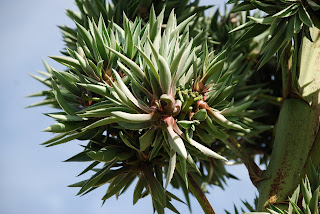 |
| How to make spicy pumpkin soup |
Come the halloween season and the shops are full of pumpkins. Small ones, humongous ones - even freaky coloured ones, but they aren't all just for cutting up to make scary faces! Choose a culinary variety and you can produce one of the most beautifully flavoured soups you've ever tasted!
I love this recipe and not for the obvious reason. I love it because the this recipe seemed so simple that when I first tried it that I was sure that it was going to end up tasting bland and weak. But I was so, so wrong. It ended up as one of the most delicious soups I have ever made!
Ingredients
1 x medium sized pumpkin approximately 1 kg
1 x large onion
3 x sticks of celery
1 x tin of chopped tomatoes
1/2 a swede or 2 x medium potatoes
50 grams of butter
1 litre of vegetable or chicken stock
1 level tsp of cumin
1/2 level tsp of chili powder or flakes
In addition you can also add 4 x rashers of bacon and/or 100ml of single cream
Peel and roughly chop the onion, then melt the butter in a large, heavy-based saucepan and gently cook the onion on a low heat until soft and translucent. Meanwhile, peel the pumpkin, discarding all the stringy bits and the seeds.
Chop the pumpkin into rough cubes and add to the onions. Cook until the pumpkin is golden brown at the edges, then add the stock.
Peel and chop the potatoes/swedes, and along with the chopped celery - chuck into the pan along with the tomatoes, cumin and chili powder/flakes. Bring to the boil then leave to simmer for 20 minutes or so until the pumpkin, is tender.
In addition you can also add 4 x rashers of bacon and/or 100ml of single cream
Peel and roughly chop the onion, then melt the butter in a large, heavy-based saucepan and gently cook the onion on a low heat until soft and translucent. Meanwhile, peel the pumpkin, discarding all the stringy bits and the seeds.
Chop the pumpkin into rough cubes and add to the onions. Cook until the pumpkin is golden brown at the edges, then add the stock.
Peel and chop the potatoes/swedes, and along with the chopped celery - chuck into the pan along with the tomatoes, cumin and chili powder/flakes. Bring to the boil then leave to simmer for 20 minutes or so until the pumpkin, is tender.
If you are using the bacon in this recipe, fry it off until it is crisp. Cool a little then cut up with scissors into small pieces. Whizz the soup in a blender or food processor until it runs smooth. the, if you are using it, pour in the cream and taste for seasoning, adding salt and pepper as necessary. Return to the pan, bring almost to the boil and then serve, piping hot, with the bacon bits scattered on top.
Serve with some freshly buttered, oven warmed bread. Absolutely delicious!
For related articles click onto the following links:
CHICKEN SOUP
HOW TO COLLECT AND PREPARE PUMPKIN SEEDS FOR GERMINATION
HOW TO CURE AND STORE PUMPKINS
HOW TO GROW PUMPKINS FROM SEED
HOW TO MAKE SPICY PUMPKIN SOUP
HOW TO MAKE STOCK FROM TURKEY BONES
HOW TO TELL WHEN PUMPKINS ARE READY TO HARVEST?
RECIPE FOR BLOOD RED HALLOWEEN SOUP
RECIPE FOR PARSLEY SOUP
THE HISTORY OF THE JACK 'O' LANTERN HALLOWEEN PUMPKIN
TOMATO SOUP
WHEN TO HARVEST PUMPKINS


















































